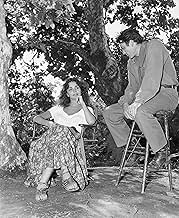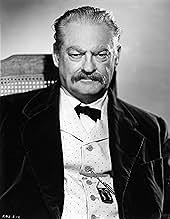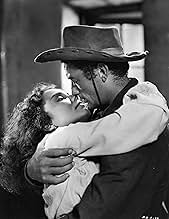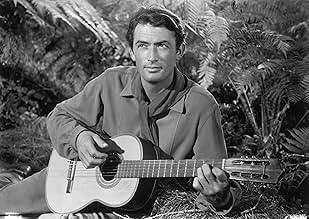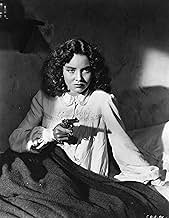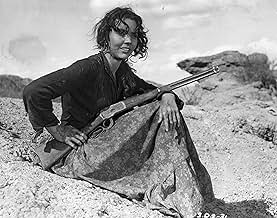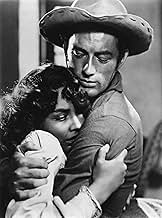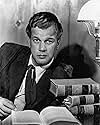ÉVALUATION IMDb
6,7/10
10 k
MA NOTE
La jolie métisse Pearl Chavez devient la pupille du premier amour de son père décédé et se retrouve déchirée entre ses deux fils, l'un bon, l'autre méchant.La jolie métisse Pearl Chavez devient la pupille du premier amour de son père décédé et se retrouve déchirée entre ses deux fils, l'un bon, l'autre méchant.La jolie métisse Pearl Chavez devient la pupille du premier amour de son père décédé et se retrouve déchirée entre ses deux fils, l'un bon, l'autre méchant.
- Nommé pour 2 oscars
- 3 victoires et 4 nominations au total
Griff Barnett
- The Bordertown Jailer
- (uncredited)
John Barton
- Party Guest
- (uncredited)
Avis en vedette
Everything about 'Duel in the Sun' is overripe: the music, the photography (those red sunsets a la GWTW), the strong emotions and the climactic duel on a blazing desert sun by the two mismatched lovers. Indeed, the excesses are almost operatic in proportion--and yet, a viewer can get caught up in this sprawling western rightly termed "Lust in the Dust" by some reviewers. The rampant sensuality of the steamy scenes between Peck and Jones are emphasized by Dimitri Tiomkin's luscious background score which becomes blistering and intense for the climactic shootout. Overproduced, overacted, overwritten--it still entertains and makes us appreciate the genius of David O. Selznick whose hand on all of the material is quite evident. Jennifer Jones was nominated for her tempestuous Pearl Chavez (but lost to Olivia de Havilland for 'To Each His Own'). Lillian Gish deserved her Oscar nomination. And last but not least, let's not forget Walter Huston, who gives the most realistic and enjoyable performance in the entire film as The Sin Killer--a wickedly funny portrayal. Weakest aspect of the film is Gregory Peck's easygoing villain--his whole performance strikes a false note and is not the least bit convincing. He and Joseph Cotten should have switched their roles--Cotten always made a more believable villain than Peck. Selznick obviously was striving to make a western on the level of GWTW--even including Butterfly McQueen for comic relief. All in all, fun to watch if you don't take any of it seriously. Not exactly a work of art--but definitely worth watching. And, oh, that ripe technicolor!
This movie is like a painting by an old master that hangs in a museum--we may not be moved by it, but we can still appreciate the artistry. Its most notable feature is the director, King Vidor, master of silent film making. As you might expect, many of the important scenes have little or no dialog. In one scene between Lionel Barrymore and Lillian Gish, he rambles on about their life together, while she strains to get out of her sickbed and crosses slowly to him, the entire distance transfigured by the depth of her love for him. Gish was a great star of silent film, with a wonderful, expressive face, full of compassion and grace. In another scene that happens under quite different circumstances, Jennifer Jones crawls to Gregory Peck, the man she loves, also without words, evincing great sorrow and quiet dignity. In both cases, the women prove they are far more noble than the men who love them so badly. Jones also has a mobile face, together with a beautiful, resonant voice. No film that has these two ladies at its center should be missed. In addition, the film has two marvelous scenes that, at the time of its making, would have been just as impressive as some of today's special effects wonders: In the first, about 20 armed horsemen face a crowd of railway workers, including some chinese, clothed in authentic period dress, with a steam engine in the background. As the tensions mount, a troop of mounted cavalry, about 100 strong, ride onto the set, filmed on location (judging by the saguarros and ocatillos) in Arizona. This was a tour de force of filmmaking at a time when shooting on location was rare. In the second scene, a train under a full head of steam jumps the tracks and plows down an embankment. Filmed in early technicolor, this movie has lush exteriors and panoramas of rich desert color. Two more character actors should be mentioned, both of whom steal every scene they enter: Butterfly McQueen, the maid whose comments are both simple and profound, and Walter Huston, as the crusty sheriff who doubles as a preacher during a funeral.
not great. only perfect. for the story, mix of different lines. for cast. and for the meet between Jennifer Jones and Gregory Peck in a last scene who impress again and again. it is a masterpiece . for the opportunity to discover a lost age of Hollywood in the best version. for the desire, and the reasonable result, to make a different western. and for its...humanitarian perspective about love and family. sure, I am far to be objective about it as admirer of Lillian Gish and Gregory Peck . but it is real good film. maybe, obvious, perfect.
Well, it's obvious that Selznick was trying his best to recapture that GWTW magic...but this is an unbelievably inept failure. Here's what you can expect from this overblown sex-western:
--Jennifer Jones (in pancake make-up so orange that she put me more in mind of an Oompa-Loompa than the half-breed we're supposed to see) apparently directed to act as though she's Scarlett O'Hara with a lobotomy and bad grammar.
--Gregory Peck as rogue murdering rapist and the apple of his daddy's eye. At one point even doing a pretty decent vocal imitation of Clark Gable -- too bad it's just the voice.
--Lionel Barrymore lazily repeating his "It's a Wonderful Life" role from the same year -- wheelchair & grumpiness standing in for effort.
--Butterfly McQueen as kerchiefed ditzy maid. Hmmm, wonder where they got that idea?
All in all, a miserable movie experience. You'd think that since they cribbed from the best it'd have turned out better! Go figure.
--Jennifer Jones (in pancake make-up so orange that she put me more in mind of an Oompa-Loompa than the half-breed we're supposed to see) apparently directed to act as though she's Scarlett O'Hara with a lobotomy and bad grammar.
--Gregory Peck as rogue murdering rapist and the apple of his daddy's eye. At one point even doing a pretty decent vocal imitation of Clark Gable -- too bad it's just the voice.
--Lionel Barrymore lazily repeating his "It's a Wonderful Life" role from the same year -- wheelchair & grumpiness standing in for effort.
--Butterfly McQueen as kerchiefed ditzy maid. Hmmm, wonder where they got that idea?
All in all, a miserable movie experience. You'd think that since they cribbed from the best it'd have turned out better! Go figure.
No need to recap the plot.
One thing about this overblown fandango— once seeing it, you won't forget it. How could anyone when everything is done to such tasteless excess. Poor Pearl (Jones). Apparently, Jones was told her part was that of a hot-blooded wench, which she unfortunately took to mean parboiled. It's hard not to laugh at the first hour when she acts like a nympho on steroids, tossing hair and leering wildly like pampas grass in a windstorm. Not far behind is that vintage ham Lionel Barrymore doing his usual blustery bit, like we won't get his hard-bitten patriarch unless he takes it into hyper speed. And who could have guessed that the usually constricted and constrained Gregory Peck could actually over-act. I think it was his first and last time—good thing, too.
It's possible to go on about the unrelenting excess— the sunsets that appear to hemorrhage, a musical score that's as necessary as sugar on molasses, and a loony ending that defies parody. But you get the idea. Too bad so much money and effort went into such a generally overheated result. Only Cotten, Gish and the black stallion come through unscathed. I'm thinking RKO could have made a dozen worthwhile programmers on the same budget. As things turned out, Selznick did his beloved Jones no favors with this one. It's hard to believe the man responsible for Gone with the Wind (1939) is also responsible for this swollen mess.
One thing about this overblown fandango— once seeing it, you won't forget it. How could anyone when everything is done to such tasteless excess. Poor Pearl (Jones). Apparently, Jones was told her part was that of a hot-blooded wench, which she unfortunately took to mean parboiled. It's hard not to laugh at the first hour when she acts like a nympho on steroids, tossing hair and leering wildly like pampas grass in a windstorm. Not far behind is that vintage ham Lionel Barrymore doing his usual blustery bit, like we won't get his hard-bitten patriarch unless he takes it into hyper speed. And who could have guessed that the usually constricted and constrained Gregory Peck could actually over-act. I think it was his first and last time—good thing, too.
It's possible to go on about the unrelenting excess— the sunsets that appear to hemorrhage, a musical score that's as necessary as sugar on molasses, and a loony ending that defies parody. But you get the idea. Too bad so much money and effort went into such a generally overheated result. Only Cotten, Gish and the black stallion come through unscathed. I'm thinking RKO could have made a dozen worthwhile programmers on the same budget. As things turned out, Selznick did his beloved Jones no favors with this one. It's hard to believe the man responsible for Gone with the Wind (1939) is also responsible for this swollen mess.
Le saviez-vous
- AnecdotesAccording to King Vidor, director Josef von Sternberg was hired only as a lighting expert by David O. Selznick in order to give his wife--and the film's star--Jennifer Jones a more glamorous look.
- GaffesThe opening shows saguaro cacti in the valley. The film is supposed to take place in Texas, but southern Arizona is the only place in the US with saguaro cacti, unless they've been transplanted.
- Citations
The Sinkiller: Under that heathen blanket, there's a full-blossomed woman built by the devil to drive men crazy.
- Autres versionsThe original "roadshow" version ran 144 minutes. The additional 16 minutes, over the commonly-shown 128 minute version, consisted of a musical "prelude," an "overture" (which contained a spoken prologue, by Orson Welles), and exit music, but no additional scenes in the film. The two additional opening sequences were each inadvertently given the other's label.
- ConnexionsEdited into Histoire(s) du cinéma: Une histoire seule (1989)
Meilleurs choix
Connectez-vous pour évaluer et surveiller les recommandations personnalisées
Détails
Box-office
- Budget
- 8 000 000 $ US (estimation)
- Brut – États-Unis et Canada
- 20 408 163 $ US
- Brut – à l'échelle mondiale
- 20 428 771 $ US
- Durée2 heures 26 minutes
- Rapport de forme
- 1.37 : 1
Contribuer à cette page
Suggérer une modification ou ajouter du contenu manquant

Lacune principale
By what name was Duel in the Sun (1946) officially released in India in English?
Répondre

